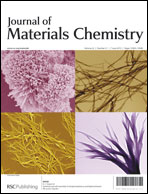Metal-free nitrogen-doped hollow carbon spheres synthesized by thermal treatment of poly(o-phenylenediamine) for oxygen reduction reaction in direct methanol fuel cell applications†
Abstract
This study described a facile and effective route for the synthesis of structurally uniform and electrochemically active nitrogen-doped hollow carbon spheres (NHCSs) via pyrolysis of hollow poly(o-phenylenediamine) (PoPD) spheres. The characters and the mechanism of the transformation between the as-prepared PoPD and the NHCSs were studied. Results showed that the ladder aromatic structure of the as-prepared PoPD was transformed into a polycyclic-type structure in which nitrogen atoms were successfully incorporated into the graphitic structures to replace the carbon atoms. The as-prepared NHCSs showed a much higher electrocatalytic current than multi-wall carbon nanotubes and nitrogen-doped carbon nanotubes for the oxygen reduction reaction through a four-electron pathway in alkaline solution. The enhanced catalytic activity of NHCSs for ORR arose from the doping of nitrogen in the form of quaternary nitrogen, along with pyridinic N and pyrrolic N. The NHCSs also presented high methanol tolerance and long-term operational stability. The results showed that the NHCSs had a promising application in direct methanol fuel cells and provided a new method to synthesize carbon-based metal-free electrocatalysts from organic polymers.


 Please wait while we load your content...
Please wait while we load your content...